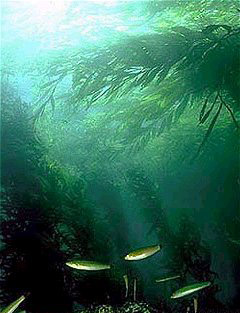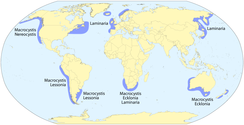| Marine habitats |
|---|
 |
| Coastal habitats |
| Ocean surface |
| Open ocean |
| Sea floor |
Kelp forests are underwater areas with a high density of kelp, which covers a large part of the world's coastlines. Smaller areas of anchored kelp are called kelp beds. They are recognized as one of the most productive and dynamic ecosystems on Earth.[1][2] Although algal kelp forest combined with coral reefs only cover 0.1% of Earth's total surface, they account for 0.9% of global primary productivity.[3] Kelp forests occur worldwide throughout temperate and polar coastal oceans.[1] In 2007, kelp forests were also discovered in tropical waters near Ecuador.[4]

"I can only compare these great aquatic forests ... with the terrestrial ones in the intertropical regions. Yet if in any country a forest was destroyed, I do not believe so nearly so many species of animals would perish as would here, from the destruction of kelp. Amidst the leaves of this plant numerous species of fish live, which nowhere else could find food or shelter; with their destruction the many cormorants and other fishing birds, the otters, seals and porpoise, would soon perish also; and lastly, the Fuegian[s] ... would ... decrease in numbers and perhaps cease to exist.
– Charles Darwin, 1 June 1834, Tierra del Fuego, Chile[5]

Physically formed by brown macroalgae, kelp forests provide a unique habitat for marine organisms[6] and are a source for understanding many ecological processes. Over the last century, they have been the focus of extensive research, particularly in trophic ecology, and continue to provoke important ideas that are relevant beyond this unique ecosystem. For example, kelp forests can influence coastal oceanographic patterns[7] and provide many ecosystem services.[8]
However, the influence of humans has often contributed to kelp forest degradation. Of particular concern are the effects of overfishing nearshore ecosystems, which can release herbivores from their normal population regulation and result in the overgrazing of kelp and other algae.[9] This can rapidly result in transitions to barren landscapes where relatively few species persist.[10][11] Already due to the combined effects of overfishing and climate change,[12] kelp forests have all but disappeared in many especially vulnerable places, such as Tasmania's east coast and the coast of Northern California.[13][14] The implementation of marine protected areas is one management strategy useful for addressing such issues, since it may limit the impacts of fishing and buffer the ecosystem from additive effects of other environmental stressors.
- ^ a b Mann, K. H. (1973-12-07). "Seaweeds: Their Productivity and Strategy for Growth: The role of large marine algae in coastal productivity is far more important than has been suspected". Science. 182 (4116): 975–981. doi:10.1126/science.182.4116.975. ISSN 0036-8075. PMID 17833778.
- ^ Pessarrodona, A; Assis, J; Filbee-Dexter, K; Burrows, M T; Gattuso, J-P; Duarte, C.M.; Krause-Jensen, D; Moore, P.J.; Smale, D.A.; Wernberg, T (23 July 2020). "Global Seaweed Productivity". Science Advances. 8 (37): eabn2465. doi:10.1126/sciadv.abn2465. hdl:10754/681467. PMC 9473579. PMID 36103524.
- ^ See Fig. 3 in Blakemore, Robert (2018). "Non-Flat Earth Recalibrated for Terrain and Topsoil". Soil Systems. 2 (4): 64. doi:10.3390/soilsystems2040064.
- ^ Graham, Michael H.; Kinlan, Brian P.; Druehl, Louis D.; Garske, Lauren E.; Banks, Stuart (2007-10-16). "Deep-water kelp refugia as potential hotspots of tropical marine diversity and productivity". Proceedings of the National Academy of Sciences. 104 (42): 16576–16580. Bibcode:2007PNAS..10416576G. doi:10.1073/pnas.0704778104. ISSN 0027-8424. PMC 2034254. PMID 17913882.
- ^ the harvard classics: voyage of the beagle. P.F. Collier & Son Company. 1909.
- ^ Christie, Hartvig; Jørgensen, Nina Mari; Norderhaug, Kjell Magnus; Waage-Nielsen, Elisabeth (August 2003). "Species distribution and habitat exploitation of fauna associated with kelp ( Laminaria Hyperborea ) along the Norwegian Coast". Journal of the Marine Biological Association of the United Kingdom. 83 (4): 687–699. Bibcode:2003JMBUK..83..687C. doi:10.1017/S0025315403007653h. ISSN 0025-3154. Archived from the original on 2024-10-07. Retrieved 2024-10-05.
- ^ Jackson, George A.; Winant, Clinton D. (May 1983). "Effect of a kelp forest on coastal currents". Continental Shelf Research. 2 (1): 75–80. Bibcode:1983CSR.....2...75J. doi:10.1016/0278-4343(83)90023-7. Archived from the original on 2024-10-07. Retrieved 2024-10-05.
- ^ Steneck, Robert S.; Graham, Michael H.; Bourque, Bruce J.; Corbett, Debbie; Erlandson, Jon M.; Estes, James A.; Tegner, Mia J. (December 2002). "Kelp forest ecosystems: biodiversity, stability, resilience and future". Environmental Conservation. 29 (4): 436–459. Bibcode:2002EnvCo..29..436S. doi:10.1017/S0376892902000322. ISSN 0376-8929. Archived from the original on 2024-10-07. Retrieved 2024-10-05.
- ^ Sala, E.; Boudouresque, C. F.; Harmelin-Vivien, M. (September 1998). "Fishing, Trophic Cascades, and the Structure of Algal Assemblages: Evaluation of an Old but Untested Paradigm". Oikos. 82 (3): 425. Bibcode:1998Oikos..82..425S. doi:10.2307/3546364. JSTOR 3546364.
- ^ Dayton, Paul K. (1985). "Ecology of Kelp Communities". Annual Review of Ecology and Systematics. 16 (1): 215–245. Bibcode:1985AnRES..16..215D. doi:10.1146/annurev.es.16.110185.001243. ISSN 0066-4162. JSTOR 2097048.
- ^ Norderhaug, Kjell Magnus; Christie, Hartvig C. (November 2009). "Sea urchin grazing and kelp re-vegetation in the NE Atlantic". Marine Biology Research. 5 (6): 515–528. Bibcode:2009MBioR...5..515N. doi:10.1080/17451000902932985. ISSN 1745-1000.
- ^ Filbee-Dexter, Karen; Feehan, Colette J.; Scheibling, Robert E. (2016-02-03). "Large-scale degradation of a kelp ecosystem in an ocean warming hotspot". Marine Ecology Progress Series. 543: 141–152. Bibcode:2016MEPS..543..141F. doi:10.3354/meps11554. ISSN 0171-8630. Archived from the original on 2024-03-31. Retrieved 2024-03-31.
- ^ Morton, Adam; Cordell, Marni; Fanner, David; Ball, Andy; Evershed, Nick. "The dead sea: Tasmania's underwater forests disappearing in our lifetime". The Guardian. Archived from the original on 2020-10-22. Retrieved 2020-10-22.
- ^ Steinbauer, James. "What Will It Take to Bring Back the Kelp Forest? - Bay Nature Magazine". Bay Nature. Archived from the original on 2020-10-20. Retrieved 2020-10-22.